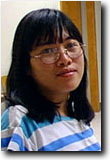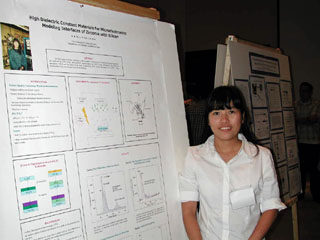What's New?
The 1999-2000 Beckman Scholars: Hau My Ho
| Faculty Mentor: Professor J. Mike White Length of term: Summer 99, Fall 99, Spring 00, Summer 00 Honors & Awards: University Honors (Spring 99, Spring 00) Publications: Sun, Y.-M. ; Lozano, J. ; Ho, H. ; Park, H. J. ; Veldman, S. ; White, J. M. Interfacial silicon oxide formation during synthesis of ZrO2 on Si(100) Applied Surface Science 161, no. 1-2 (2000): 115. Ho, Hau My ; Cui, Bianxiao ; Repel, Stephen ; Lin, Binhua ; Rice, Stuart A. Influence of a depletion interaction on dynamical heterogeneity in a dense quasi-two-dimensional colloid liquid J. Chem. Phys. 121, no. 17(2004): 8627-8634. Ho, Hau My; Lin, Binhua; Rice, Stuart A. Three-particle correlation functions of quasi-two-dimensional in one-component and binary colloid suspensions. J. Chem. Phys. 125, no. 18, (2006): 184715/1-184715/14. Valley, David T; Rice, Stuart A; Cui, Bianxiao; Ho, Hau My; Diamant, Haim; Lin, Binhua. Pair diffusion in quasi-one- and quasi-two-dimensional binary colloid suspensions. J. Chem. Phys. 126, no. 13 (2007): 134908-17430068. Lin, Binhua ; Valley, David ; Meron, Mati ; Cui, Bianxiao ; Ho, Hau My ; Rice, S. A. "The Quasi-One-Dimensional Colloid Fluid Revisited" J. Phys. Chem. B 113, no. 42, (2009): 13742-13751. Where is she now? Graduated with BSc (Chemistry) and a BSc (Biochemistry) , May 2000 and an MS (Chemistry) from U Chicago. Hau worked as a Research Assistant at UT Southwestern Medical Center, and is now back at UT Austin in the PharmD program. How can I contact her?huhohoho at gmail.com |
 |
Beckman research project in the White group:
High dielectric constant materials for microelectronics:
Modeling interfaces of zirconia with silicon
The goals of this Beckman Scholar project relate to a problem of fundamental and technological interest, namely, the formation and properties of interfaces between dielectric materials and silicon. Dielectrics and silicon form the basis for much of modern electronics technology. As device structures shrink in size into the sub-0.25 micron regime, in order to enhance device speed and compactness, the interfaces between the dielectric and the semiconductor become more important. The argument can be made that there is no longer any bulk dielectric because it is so thin (< 0. 3 nm). The chemical properties of these interfaces are of central importance and lie at the heart of the proposed project.
Zirconium Dioxide is found to be a good candidate for a high dielectric material useful in these situations, with a dielectric constant of 22, showing good adhesion to Si(100) substrate surfaces, and it has a wide bandgap (5.16eV), i.e., it has high barrier heights to electrons and holes from silicon. In addition, ZrO2 is thermodynamically stable in the presence of silicon. However, it has been observed that ZrO2 films deposited on Si(100) using PVD (physical vapor deposition) contain interface silicon dioxide layers which reduce the usefulness of the material as a barrier due to the low k value of SiO2 (4.1 eV). Thus the questions to be resolved were: Will the deposition of Zr reduce the silicon dioxide layer when it is dosed onto a thin layer of SiO2, and what interfacial reactions occur between Zr and Si(100) covered with native oxide.
To answer these questions, Zr films were prepared on bare and native oxide-covered silicon substrates using PVD at low pressure (on the order of 10-7 to 10-8 torr). Chemical analysis was carried out subsequently using X-ray photoelectron spectroscopy (XPS) and X-ray Diffraction (XRD). The films were found to be amorphous (XRD) and the silicon oxide layer is reduced at 300 K during deposition of Zr (XPS). Non-stoichiometric zirconium silicate was found to form at the interface according to the reaction:
Zr + SiO2 < > ZrSiYOX (x < 2, y < 2).

Created and maintained by Ruth Shear. Comments to author at DrRuth@mail.utexas.edu
Created Mon Mar 22nd 1999. Last modified Mon, Mar 10, 2014.